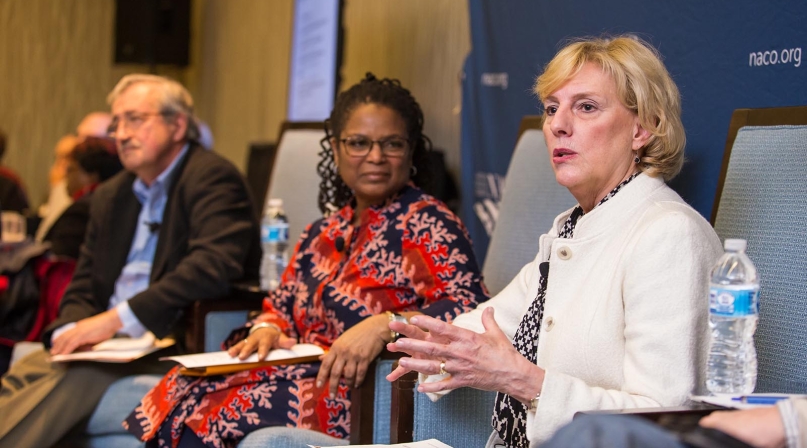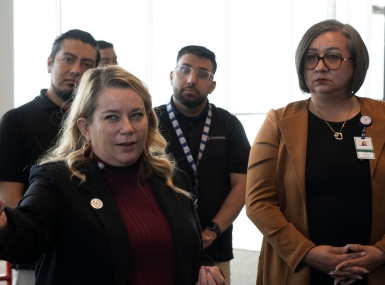Innovation, collaboration key to combating two-generation poverty, county officials say

Linking community leaders and policy makers is crucial for addressing poverty
At a standing-room-only luncheon discussion on combating two-generation poverty at NACo’s Legislative Conference March 3, the word of the hour was “innovation.” That’s what panel members said is needed to break down long-held ways of dealing with poverty.
Panel discussion member Arapahoe County, Colo. Commissioner Nancy Sharpe noted that her county has 17,000 children who live in poverty out of a population of 640,000. “What we really started focusing on was innovation,” she said.
“We were really seeing the silos we had working with children and their parents,” she said. “Sometimes we don’t see what each is doing. We think about how the programs bring families together.” Sharpe noted that silos exist across the board locally, statewide and on the federal level. “How do we bring siloed agencies to all work together?”
Sharpe also said that her county is “all about collecting data. Are we really achieving our goals?”
“What truly will change this is innovation,” said Weber County, Utah Commissioner James Ebert, adding that his county had found “alarming” numbers of children in poverty, with 24 percent at-risk of living in poverty as they get older.
Collaboration was another key word at the March 3 luncheon. Ebert said bringing community leaders and policy makers together is important when trying to stamp out poverty in your county.
The panel discussion, which also included Duane Yoder, president of Garrett County, Md. Community Action Committee, was moderated by the Aspen Institute’s Marjorie Sims. NACo President Roy Charles Brooks, Tarrant County, Texas commissioner, is raising awareness about the county role in addressing poverty.
In addition to the luncheon panel discussion, another session explored how counties can cut through red tape to better reach families in need.
Cutting through red tape in Dakota County, Minn.
Dakota County, Minn. got the ball rolling to connect families in the WIC (Women, Infants and Children) program to its Birth to Age 8 Collaborative Initiative by cutting through some red tape, according to Dakota County Manager Matt Smith.
Due to privacy laws, the county was initially unable to connect WIC families with the program, but a county attorney and state lawmakers created a consent form that everyone was comfortable with.
That was one of the nuggets of information revealed March 6 at “Counties Care: How to Effectively Serve Families in Need.”
Carol Moehrle, district director, Public Health, Idaho North Central District, which covers Clearwater, Idaho, Latah, Lewis and Nez Perce counties, said that more and more, various entities are working together instead of being “siloed.” Some of their home visiting referrals, for instance, are coming from the court system. “If they want to keep their children, they must have a home visit,” she said.
“We all have a stake in the game,” she said. “Counties seem to be that place for common discussions to be had.”
An audience member from Georgia noted that one of his county’s biggest struggles was finding ways to reduce “provider fatigue” — stress among providers who visit families, day in and day out, with social problems. Another challenge? Finding affordable housing for program providers.
Finding people to employ, specifically nurses, was another problem for a county official from North Carolina, who said a position has been open since spring of 2016. The county is considering finding ways to collaborate with surrounding counties.
NACo members also took part in a press briefing March 6 on Capitol Hill on multigenerational poverty, where they discussed the issue and heard from members of Congress.
Quality, affordable childcare is the key to help poverty-stricken families, said Rep. Bobby Scott (D-Va.). If parents know their children are being taken care of, they can get to work themselves. “If it’s not affordable, it’s not accessible,” he said. “And if it’s not affordable, parents can’t go to work. And it can’t be affordable unless it’s subsidized.”
Mobile County, Ala. Commissioner Merceria Ludgood said you sometimes have to drill down to see “pockets of poverty.” Poverty rates for children under 18 are rising in her district, she said. “As we sit here today, it’s approaching 30 percent. We have 6,000 homeless children in our school system. We have low unemployment...but it doesn’t take into account that there are pockets of poverty, ZIP codes, most in my district, that have unemployment rates between 10 percent and 25 percent.”
The University of South Alabama Office of Community Engagement will help the county hold community conversations about ways to combat poverty, Ludgood said. After hearing from the community, there are plans to meet with policymakers, she said.
Sen. Martin Heimrich (D-N.M.) echoed what many said during the conference, that various entities need to work together and not in a siloed way to combat poverty. “You can’t even access many of the programs you need, to get yourself out of a desperate situation,” he said. Nutritional assistance, workforce programs, child care and transportation programs should all be accessible to residents in need in one location, he said. He also noted that local government needs to have flexibility and discretion to blend them together in a way that works best for their communities.
Attachments
Related News

El Paso County, Texas helps migrants on their way
Though they don't often stay more than a day, asylum seekers receive care and services from El Paso County, Texas before they leave for their next destination.

L.A. County fends off homelessness with an assist from A.I.
A predictive model pulls data from six county departments to create a list of the county’s most vulnerable population — people who frequently show up in the county’s criminal justice and hospital systems and who access benefits like SNAP.

